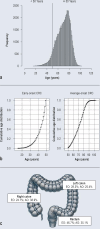Clinical Features in Patients With Early-Onset Colorectal Cancer: An Evaluation of Data From the StuDoQ Database
- PMID: 40043210
- PMCID: PMC12516330
- DOI: 10.3238/arztebl.m2025.0018
Clinical Features in Patients With Early-Onset Colorectal Cancer: An Evaluation of Data From the StuDoQ Database
Abstract
Background: The incidence of colorectal cancer (CRC) in patients who are less than 50 years old (early-onset colorectal cancer, EO-CRC) has risen markedly around the world in recent decades. Because of a lack of early detection programs for young patients, EO-CRC is often not detected until it has reached an advanced stage. In this study, we compared surgical patients with EO-CRC to those with so-called average-onset CRC (> 50 years; AO-CRC) using data from a large patient collective.
Methods: 63 565 cases of CRC from the years 2013-2022 were identified in the StuDoQ database of the German Society for General and Visceral Surgery (Deutsche Gesellschaft für Allgemeinund Viszeralchirurgie, DGAV) and were analyzed on the basis of tumor-related and perioperative data for each of two groups, EO-CRC (3549 patients) and AO-CRC (60 016 patients).
Results: The mean age in the two groups was 42.50 ± 6.3 and 71.59 ± 10.3 years. In the EO-CRC group, 26.2% of the patients were under 40, and 50.4% were under 45. Men predominated in both groups. The distribution of tumor sites differed, with more rectal carcinoma and left-sided CRC in the EO-CRC group. More patients had nodal or distant metastases in the EO-CRC group. Compared to patients in the AO-CRC group, those in the EO-CRC group much more commonly had inflammatory bowel disease (OR 5.83, 95% confidence interval [4.73; 7.16]), a genetic predisposition (OR 4.36 [3.54;5.35]), or a positive family history (OR 4.54 [4.17; 4.95]).
Conclusion: This analysis reveals that patients with EO-CRC differ markedly from those with AO-CRC in tumor-related data, multimodal treatment approaches, and perioperative outcomes. Risk-based, individualized early detection programs should be established to prevent the progression of undetected EO-CRC.
Figures


References
-
- Sinicrope FA. Increasing incidence of early-onset colorectal cancer. N Engl J Med. 2022;386:1547–1558. - PubMed
-
- Patel SG, May FP, Anderson JC, et al. Updates on age to start and stop colorectal cancer screening: Recommendations from the U.S. Multi-Society Task Force on colorectal cancer. Gastroenterology. 2022;162:285–299. - PubMed
Publication types
MeSH terms
LinkOut - more resources
Full Text Sources
Medical

